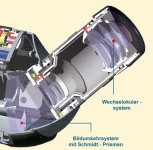I received the Nikon 8x32 SE's I ordered from Adorama and man are those things impressive! I can't believe how sharp and bright they are. No wonder they have such a following in the birding world. Once I got the IPD adjusted correctly I get no blackouts and what a view. The view is absolutely beautiful. I had some 10x42 SE's awhile back and I got alot of blackouts with them. Not so with the 8x32's. They are definitely sharper and brighter than my Nikon LX L 8x32's. The 3D view is awesome. They are quite light and they actually fit my hands quite well. The rubber eyecups don't bother me at all because they seem to be perfect with perfect eye relief. Too bad they are not waterproof but if you want the best optics you can't go wrong these. It's obvious porro prisms have many inherent advantages when you look through these.
Dennis
Dennis





